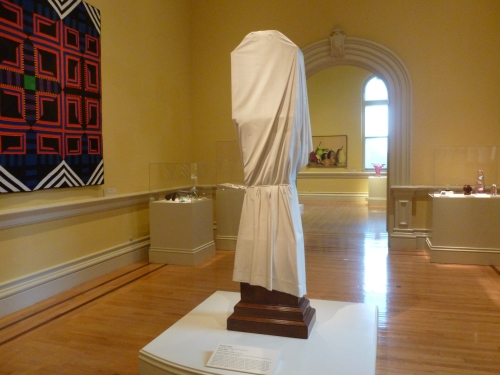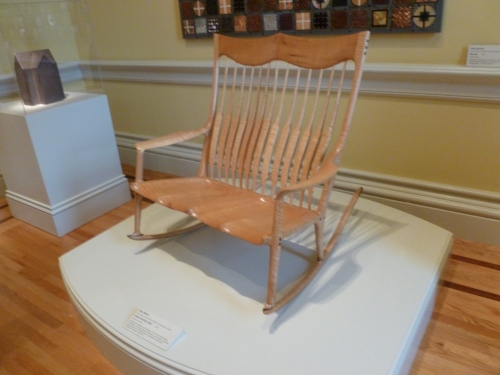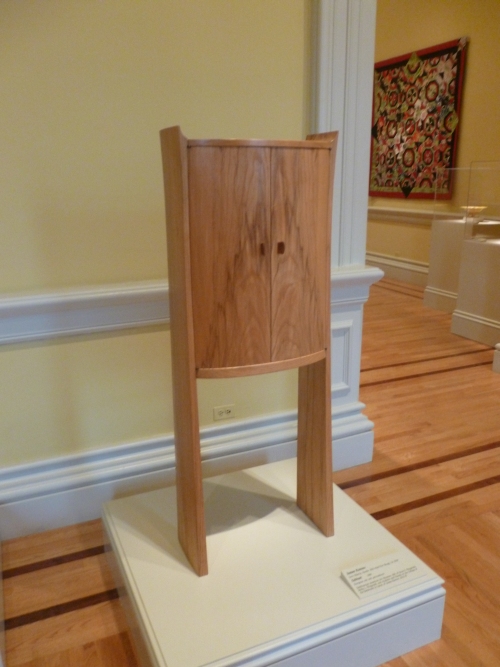 In 1984 art dealer Sandy Millikan sat down with Wendell Castle and said "Wendell, if you do another show of furniture, you are going to get labeled a furnituremaker. If you want to be an artist and be in the fine arts world, I think you have to deal with the issue of art. Now how do we do that?" (from FWW #59). The result was a exhibition of thirteen clocks, including the non-functional "Ghost Clock" which is one of the centerpieces of the modern furniture on display in the permanent collection of the Renwick Gallery in Washington DC. In 1984 art dealer Sandy Millikan sat down with Wendell Castle and said "Wendell, if you do another show of furniture, you are going to get labeled a furnituremaker. If you want to be an artist and be in the fine arts world, I think you have to deal with the issue of art. Now how do we do that?" (from FWW #59). The result was a exhibition of thirteen clocks, including the non-functional "Ghost Clock" which is one of the centerpieces of the modern furniture on display in the permanent collection of the Renwick Gallery in Washington DC.
The Renwick, which is part of the Smithsonian Institute, states on their website "The collection, exhibition program and publications presented by the Renwick Gallery highlight the best craft objects and decorative arts from the 19th century to the present."
But it doesn't. And this is what so disappointing to me. What it mostly shows is well made art objects that have no relationship at all to the working craftspeople in this country.
One of the glaring differences between the furniture in great collections such as Winterthur, The Metropolitan Museum of Art, and the Kaufman collection at the National Gallery is that the furniture in those collections represents the high end of furniture that was actually used. Some cabinetmaker, signed or anonymous, made something for some customer, and it got delivered and used in their house. Sure, it's mostly fancy stuff, but the work had context. These days hundreds of cabinetmakers are making furniture and architectural woodwork pieces, some spectacular, that have similar context, for use the way people use built objects today. The museum world ignores them.
 How is anyone supposed to learn about how modern craft fits in their world if the educational resources are stuck in an ivory tower? Where are the exhibits of real modern woodworking? I have customers who are doing spectacular work for clients. Sometimes it's furniture, but more usually interiors. Bedrooms, living room, and of course kitchens. It's not all good, but some is real great, and some shows great craft. How is anyone supposed to learn about how modern craft fits in their world if the educational resources are stuck in an ivory tower? Where are the exhibits of real modern woodworking? I have customers who are doing spectacular work for clients. Sometimes it's furniture, but more usually interiors. Bedrooms, living room, and of course kitchens. It's not all good, but some is real great, and some shows great craft.
By the way, Wendell Castle is a really talented guy, an early issue of FWW showed off some of his more useful functional pieces. It's a shame that the Renwick isn't showing something that is much harder to design than an art piece. You see, to design a piece of furniture (or building) that is functional, useful, and also passes a sniff nest of master craftsmanship, art, and engenders thoughtful discussion is a lot harder than just making some art piece. I think also in our society if a piece is functional it's automatically downgraded as possible art.
Yes, you say, but what about the Maloof double rocker and Krenov cabinet on display in the same exhibit? Those pieces are functional. They are and I was very happy to see them. I'm a big Maloof fan and copied one of his desks years ago. But I would suggest that the pieces on display by both Krenov and Maloof are more art pieces than other furniture these makers made for use in daily life. The Kenov cabinet, which is elegant and lovely, isn't a practical piece in any modern context. It's a curio cabinet, not a take on furniture Americans regular use in their houses. The Maloof double rocker is almost a joke on his signature single rocker - which is awesome. Maloff built hundreds of pieces that are absolutely modern in their usage. This chair is a collectible, more than something one would sit in every day. His rockers are great modern furniture and what would you rather own, one of his regular rockers that are comfortable and fun, or this double rocker, which you might sit in when? His desks are wonderful examples on how modern craft can interpret classic forms.
 Here is what I want to see at the Renwick: An exhibit of modern desks. I want to see what people are making to actually use as desks in the modern computer age. From fancy financial workstations, to something elegant and comfortable that works with my laptop and printer. I want to be inspired. I want to see the best of modern architectural woodworking. For example, more than a decade ago there was a bar in NYC called Iridum where upstairs the interior looked like it was built by the mad hatter's cabinetmaker. Nothing was square, everything was curved, crazy, and unbelievably cool. I haven't been there in over a decade and I don't know what remains of the original interior) But that's great design and great craft was needed to pull it off. This is what should be on exhibit. Here is what I want to see at the Renwick: An exhibit of modern desks. I want to see what people are making to actually use as desks in the modern computer age. From fancy financial workstations, to something elegant and comfortable that works with my laptop and printer. I want to be inspired. I want to see the best of modern architectural woodworking. For example, more than a decade ago there was a bar in NYC called Iridum where upstairs the interior looked like it was built by the mad hatter's cabinetmaker. Nothing was square, everything was curved, crazy, and unbelievably cool. I haven't been there in over a decade and I don't know what remains of the original interior) But that's great design and great craft was needed to pull it off. This is what should be on exhibit.
Note: Another issue I have with the Renwick and just about every furniture exhibit on the planet is the insistence of curators to display all furniture on three inch platforms. Sure it's great for making sure people don't bump into valuable stuff, but the raised height gives a deceptive sense of scale to the work.
Some museums do it right. Many years ago I was at the Design Museum at Canary Wharf in London and in addition to all the stuff roped off the museum had assembled a group of about a dozen modern chairs, all reproductions of the iconic designs of the twentieth century, and you were welcome to sit in them. I learned more about chairs and appreciating modern design in twenty minutes that you could possible believe.
In other News:
I will be at Woodworking In America in Cincinnati on October 18-20th. Unlike previous years we will be bringing lots of stuff for sale along with a cool display. We also are hoping for a giveaway tool - more on that when it happens. I was absolutely thrilled to hear that for the first time this year the marketplace will be free for spouses. Kids have always been admitted free. So bring your wife (or husband), bring the kids, show them how exciting it all is. Make some sawdust. I'm going to have a great time - you will too.
Next weekend (not this coming weekend) is Maker Faire NYC. It's at the Science Museum in Flushing. This year is bigger than ever. We will have a booth, a giveaway (if you come early enough), and at Sunday 2:30 at Maker Square I will be doing a demonstration on sharpening. Just before me Nicholas Phillips is demonstration French Polishing. On Saturday, Wilbur Pan will be talking about The Convergence of Japanese and Western Woodworking Tools. In addition it's a great show to bring the kids with lots of activities for them to do.
By the way, while I am as I say, disappointed, at the craft at the Renwick, if you want to see modern craft - Maker Faire, Woodworking in America - this is where some great craft is happening today.
While we are at it a quick shout out to the Forbes Gallery (update: closed). A small museum on lower fifth, after they sold their monopoly collection I was worried what would happen but I am happy to report that their new exhibits are great. "Out of This World: Jewelry in the Space Age" had some wonderful stuff in it and was tons of fun. The pictures by Irving Penn Show you how great great portraiture can be. If you are in the area - stop by and visit. Free.
|
 Joel's Blog
Joel's Blog Built-It Blog
Built-It Blog Video Roundup
Video Roundup Classes & Events
Classes & Events Work Magazine
Work Magazine


 In 1984 art dealer Sandy Millikan sat down with Wendell Castle and said "Wendell, if you do another show of furniture, you are going to get labeled a furnituremaker. If you want to be an artist and be in the fine arts world, I think you have to deal with the issue of art. Now how do we do that?" (from FWW #59). The result was a exhibition of thirteen clocks, including the non-functional "Ghost Clock" which is one of the centerpieces of the modern furniture on display in the permanent collection of the
In 1984 art dealer Sandy Millikan sat down with Wendell Castle and said "Wendell, if you do another show of furniture, you are going to get labeled a furnituremaker. If you want to be an artist and be in the fine arts world, I think you have to deal with the issue of art. Now how do we do that?" (from FWW #59). The result was a exhibition of thirteen clocks, including the non-functional "Ghost Clock" which is one of the centerpieces of the modern furniture on display in the permanent collection of the  How is anyone supposed to learn about how modern craft fits in their world if the educational resources are stuck in an ivory tower? Where are the exhibits of real modern woodworking? I have customers who are doing spectacular work for clients. Sometimes it's furniture, but more usually interiors. Bedrooms, living room, and of course kitchens. It's not all good, but some is real great, and some shows great craft.
How is anyone supposed to learn about how modern craft fits in their world if the educational resources are stuck in an ivory tower? Where are the exhibits of real modern woodworking? I have customers who are doing spectacular work for clients. Sometimes it's furniture, but more usually interiors. Bedrooms, living room, and of course kitchens. It's not all good, but some is real great, and some shows great craft.  Here is what I want to see at the Renwick: An exhibit of modern desks. I want to see what people are making to actually use as desks in the modern computer age. From fancy financial workstations, to something elegant and comfortable that works with my laptop and printer. I want to be inspired. I want to see the best of modern architectural woodworking. For example, more than a decade ago there was a bar in NYC called
Here is what I want to see at the Renwick: An exhibit of modern desks. I want to see what people are making to actually use as desks in the modern computer age. From fancy financial workstations, to something elegant and comfortable that works with my laptop and printer. I want to be inspired. I want to see the best of modern architectural woodworking. For example, more than a decade ago there was a bar in NYC called
AMEN!!!! Great blog post, and I couldn't agree more. I hope more people complain, so that museums can open their eyes and their wallets.
Cheers,
FR
I totally agree about the museums attitude, though, unfortunately it is a hold-over of modernism, which I believe is finally on the way out. Modernism and it's lack of rules and craftsmanship needed to happen in an art world that had become too entrenched in it's own competency, but it's time we got back to skill in art and craft.
I quite agree with you that the use of plinths in museum displays totally destroys the sense of scale of exhibited furniture. However, having volunteered at a busy west-coast museum, I understand the terror which strollers and wheelchair footrests strike in the hearts of curators.
After selling work throughout the 90s at craft events on the East Coast, in the interests of raising a couple kids I stopped traveling for many years. In the last year I exhibited at a couple shows, and was quite disappointed in the direction I see many craft artists going. Not just furniture, but ceramics and textiles as well. It's almost as if work isn't taken seriously unless it is overdone and a little too precious.
I could get into the details, but I think Joel makes the point rather well.
At the same time, I would not fully agree. To the extent that the Renwick's rotating exhibits provide the opportunity to demonstrate more diversity, some of what you are looking for is being met. And while some of the Renwick's work is clearly a reflection of the Furniture as Art movement, others are simply exemplars and in that regard may be an elevation of the form but still the form.
My points of disagreement, though, do not minimize my full agreement that an exhibit of desks or an exhibit of other furniture objects, showing the tasks, skills, tools, and devices of modern furniture-makers, would be excellent.
I like how the MFA in Boston has the 'Please Be Seated' interactive tour where you can sit on benches made by Malood, Tage Frid and others. I enjoyed getting to see and touch some of these items as it helped with my own design and scale decisions:
http://www.mfa.org/explore/interactive-tours
MESDA at Old Salem in NC also has guided tours of the collection, many pieces of which are not on pedestals etc. which was neat to see in context.
I,too, was somewhat disappointed by the permanent contemporary collection. Really very sparse and limited to craftsmen who have attained "museum" status. But this is just a reflection of the museum world as a whole--where artists/makers need to have earned the imprimatur of elite critics to be taken seriously in permanent collections. Short-term exhibitions ought to be another matter, however.
It's emphasis is more on furniture people will actively use, rather than Objects d'vertu.
http://fullercraft.org/event/massmade-20th-21st-century-studio-furniture/
Happy Maker Faire!
btw- the ghost clock is dumb.
While most of your comments focus on the curatorial choices the Renwick makes, there may be a real opportunity for input on some of the physical aspects of the way the items are displayed. The Renwick is in the design phase now of a major renovation. They'll close for two years starting in December while they completely redo the interior spaces.
More info is here:
http://newsdesk.si.edu/releases/smithsonian-american-art-museum-announces-major-renovation-its-renwick-gallery
Best,
Jay